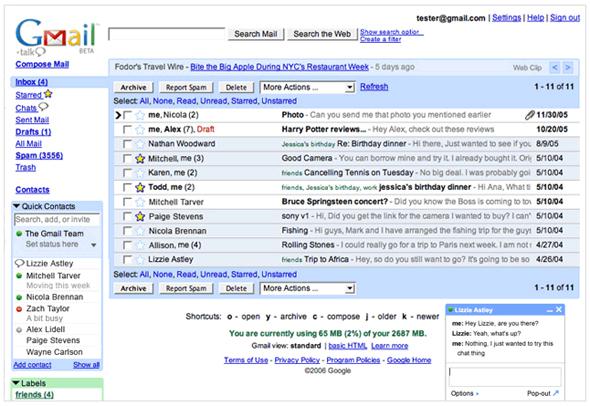Everyone has been talking about Slack lately. The chat app, which is primarily aimed at offices and productivity, is simple, well designed, fun to use, and powerful. Slack is also the company people were obsessed with in 2015. Whether you love the product or not, though, it’s time to admit something: Slack is just Gchat.
10 Years ago people didn’t necessarily understand that they could use Gchat the way they use Slack now. They envisioned it as a way to talk to people and goof off, not work with colleagues and teammates. But Gmail archived chats, made them searchable, allowed for group chats, and facilitated media transfers. It’s Slack, and Google had it (in a less evolved form) in 2005 without realizing it.
Of course Google didn’t invent instant messaging. To deny the importance of AOL Instant Messenger (AIM) would be to deny the formative experiences of most millennials. (Don’t forget about the ICQ, MSN Messenger, and Yahoo! Messenger crowd, too.) But Google made broad interoperability the main goal of Gchat and supported AIM integration, for example, by the end of 2007. As Gmail’s popularity grew and Gchat incorporated more and more messaging services, the product became an increasingly beloved choice.
The first sign that Google didn’t love Gchat the way consumers did was in the name. We can talk about Gchat all day, but Google never officially acknowledged that as the service’s title or explained why it wasn’t. The company staunchly referred to the application (released in 2005) as Google Talk and the Gmail integration (released in 2006) as Google Chat or just Chat.
It took some creative linguistics to deal with the situation. Mashable wrote that the service was “officially called Google Talk and unofficially known as Gchat.” The Telegraph tried, “Google Talk, more colloquially known as Google chat or Gchat.” It was confusing! And for Gchat’s loyal user base it felt like loving Gchat—both the name and the community that grew around the service—was somehow illegitimate.
In 2011 Google started experimenting with a communication tool called Hangouts in Google+ and by 2013 Google wanted Hangouts to be the new Gchat. It had advanced video calling features, location sharing, and support for GIFs. Basically Hangouts was a natural evolution. But many Gchat users resented the transition and criticized the new product, clinging to the classic Gchat interface. “So I just ‘upgraded’ to google hangout and now the chat column on my gmail is jankey,” one Gchat user wrote on a Google help forum in 2013 as Google ramped up the pressure on users to transition.
Two years later, John Brownlee wrote an impassioned defense of classic Gchat on Fast Company:
There’s a reason that online professionals love Gchat. In a world of instant message clients that feel like a Tokyo Pop fever dream, Gchat was proudly text-based. Putting functionality first, it co-existed with Gmail without ever trying to overpower it. … When you clicked on a name to message someone, you could send them text, and later initiate a video conference, but that’s it. … It was proudly, even defiantly no frills, but it still had some beautiful, understated touches.
Presenting the new version as a rebrand and replacement seemed to confirm the suspicion that Google didn’t really love Gchat the way users did. And it was also the moment where the company’s vision for chat stopped making sense. In its company history, Google writes that as of May 2013 Hangouts “will be Google’s single communications system, replacing Google Talk, Google+ Hangouts and Messenger.” Yet Google Messenger still exists alongside Hangouts. And there are even still some holdout users on old-style Gchat.
But wait, there’s more.
Last week, Google announced an instant message app and a video chat app, called Allo and Duo respectively, that incorporate personalization through machine learning. The company also announced a collaboration and productivity app called Spaces the week before that mixes multimedia sharing and in-app web browsing with chat.
This seems like, well, a lot of communication options. A Google spokesperson told me in a statement that, “With Allo and Duo, we’ve focused on starting from the ground up, building mobile-only single-purpose apps. Hangouts on the other hand is a strong multiplatform app, serving the needs of users in productivity and group scenarios.” Google seems to add new brands whenever they build new products, even when there is extensive overlap in functionality.
From an internal perspective it makes sense to start with a clean slate and then show off exciting and novel work. “We didn’t want to weigh down the [engineering] team with decisions from previous products,” Erik Kay, Google’s engineering director for communication software, told CNET on Sunday. But from the consumer perspective, these name changes can read as redundant and disrespectful to beloved products that could be improved instead of phased out. (RIP Google Reader.)
In a meditation on Digital Trends about Google’s glut of communication apps, Andy Boxall wrote that Google was “vomiting out three new messaging apps. … Which one should we use? If you’re not sure, don’t look at Google. Based on its confused approach to messaging, it doesn’t have a clue either.” This speaks to the idea that Google had something much more valuable than it realized with Gchat. Back in 2005 and 2006 the company was offering the foundation of what would become the next big trend. Gchat was simple, elegant, and most importantly, focused. That’s all gone now.
Beyond just Slack, Google was five or six years ahead of WhatsApp, GroupMe, and Facebook Messenger on offering a fun, functional chat app with lots of features. The company could have won the day if it understood what it had. In fact it’s still common to hear people calling any Google communication product Gchat. It’s an impressively powerful brand, especially given that it never existed.
